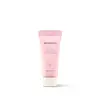What's inside
What's inside
 Key Ingredients
Key Ingredients

 Benefits
Benefits

 Concerns
Concerns

 Ingredients Side-by-side
Ingredients Side-by-side

Glycerin
HumectantRosa Damascena Flower Extract
MaskingMyristic Acid
CleansingPalmitic Acid
EmollientWater
Skin ConditioningStearic Acid
CleansingPotassium Hydroxide
BufferingLauric Acid
CleansingCocos Nucifera Oil
MaskingSodium Cocoamphoacetate
CleansingSodium Cocoyl Isethionate
CleansingGlyceryl Stearate
EmollientSorbitan Olivate
EmulsifyingErythritol
HumectantCalendula Officinalis Flower Extract
MaskingPhyllanthus Emblica Fruit Extract
HumectantRosa Canina Fruit Extract
AstringentRubus Idaeus Leaf Extract
Skin ConditioningSambucus Nigra Fruit Extract
AstringentPhenethyl Alcohol
MaskingCaprylyl Glycol
EmollientPolyquaternium-39
Sodium Chloride
MaskingPropanediol
SolventEthylhexylglycerin
Skin ConditioningEclipta Prostrata Extract
Skin ConditioningCitronellol
PerfumingLinalool
PerfumingGeraniol
PerfumingHippophae Rhamnoides Oil
EmollientPelargonium Graveolens Oil
MaskingMelia Azadirachta Leaf Extract
Skin Conditioning1,2-Hexanediol
Skin ConditioningChamomilla Recutita Flower Extract
MaskingRosmarinus Officinalis Leaf Extract
AntimicrobialVerbena Officinalis Extract
EmollientSodium Benzoate
MaskingAniba Rosodora Wood Oil
AstringentSodium Hyaluronate
HumectantMoringa Oleifera Seed Extract
Skin ConditioningGlycerin, Rosa Damascena Flower Extract, Myristic Acid, Palmitic Acid, Water, Stearic Acid, Potassium Hydroxide, Lauric Acid, Cocos Nucifera Oil, Sodium Cocoamphoacetate, Sodium Cocoyl Isethionate, Glyceryl Stearate, Sorbitan Olivate, Erythritol, Calendula Officinalis Flower Extract, Phyllanthus Emblica Fruit Extract, Rosa Canina Fruit Extract, Rubus Idaeus Leaf Extract, Sambucus Nigra Fruit Extract, Phenethyl Alcohol, Caprylyl Glycol, Polyquaternium-39, Sodium Chloride, Propanediol, Ethylhexylglycerin, Eclipta Prostrata Extract, Citronellol, Linalool, Geraniol, Hippophae Rhamnoides Oil, Pelargonium Graveolens Oil, Melia Azadirachta Leaf Extract, 1,2-Hexanediol, Chamomilla Recutita Flower Extract, Rosmarinus Officinalis Leaf Extract, Verbena Officinalis Extract, Sodium Benzoate, Aniba Rosodora Wood Oil, Sodium Hyaluronate, Moringa Oleifera Seed Extract
Water
Skin ConditioningDisodium Cocoamphodiacetate
CleansingDisodium Laureth Sulfosuccinate
CleansingGlycerin
HumectantAcrylates Copolymer
Potassium Cocoyl Glycinate
Laminaria Japonica Extract
Skin ProtectingHydrolyzed Hyaluronic Acid
HumectantTocopherol
AntioxidantFructooligosaccharides
HumectantEclipta Prostrata Leaf Extract
Skin ConditioningBeta-Glucan
Skin ConditioningLithospermum Erythrorhizon Root Extract
Skin ConditioningSodium Chloride
MaskingCeramide AP
Skin Conditioning1,2-Hexanediol
Skin ConditioningDecylene Glycol
Skin ConditioningTromethamine
BufferingSodium Benzoate
MaskingHexylene Glycol
EmulsifyingDipropylene Glycol
HumectantHydrogenated Lecithin
EmulsifyingCitric Acid
BufferingEthylhexylglycerin
Skin ConditioningWater, Disodium Cocoamphodiacetate, Disodium Laureth Sulfosuccinate, Glycerin, Acrylates Copolymer, Potassium Cocoyl Glycinate, Laminaria Japonica Extract, Hydrolyzed Hyaluronic Acid, Tocopherol, Fructooligosaccharides, Eclipta Prostrata Leaf Extract, Beta-Glucan, Lithospermum Erythrorhizon Root Extract, Sodium Chloride, Ceramide AP, 1,2-Hexanediol, Decylene Glycol, Tromethamine, Sodium Benzoate, Hexylene Glycol, Dipropylene Glycol, Hydrogenated Lecithin, Citric Acid, Ethylhexylglycerin
 Reviews
Reviews

Ingredients Explained
These ingredients are found in both products.
Ingredients higher up in an ingredient list are typically present in a larger amount.
1,2-Hexanediol is a synthetic liquid and another multi-functional powerhouse.
It is a:
- Humectant, drawing moisture into the skin
- Emollient, helping to soften skin
- Solvent, dispersing and stabilizing formulas
- Preservative booster, enhancing the antimicrobial activity of other preservatives
Ethylhexylglycerin (we can't pronounce this either) is commonly used as a preservative and skin softener. It is derived from glyceryl.
You might see Ethylhexylglycerin often paired with other preservatives such as phenoxyethanol. Ethylhexylglycerin has been found to increase the effectiveness of these other preservatives.
Glycerin is already naturally found in your skin. It helps moisturize and protect your skin.
A study from 2016 found glycerin to be more effective as a humectant than AHAs and hyaluronic acid.
As a humectant, it helps the skin stay hydrated by pulling moisture to your skin. The low molecular weight of glycerin allows it to pull moisture into the deeper layers of your skin.
Hydrated skin improves your skin barrier; Your skin barrier helps protect against irritants and bacteria.
Glycerin has also been found to have antimicrobial and antiviral properties. Due to these properties, glycerin is often used in wound and burn treatments.
In cosmetics, glycerin is usually derived from plants such as soybean or palm. However, it can also be sourced from animals, such as tallow or animal fat.
This ingredient is organic, colorless, odorless, and non-toxic.
Glycerin is the name for this ingredient in American English. British English uses Glycerol/Glycerine.
Learn more about GlycerinSodium Benzoate is a preservative. It's used in both cosmetic and food products to inhibit the growth of mold and bacteria. It is typically produced synthetically.
Both the US FDA and EU Health Committee have approved the use of sodium benzoate. In the US, levels of 0.1% (of the total product) are allowed.
Sodium benzoate works as a preservative by inhibiting the growth of bacteria inside of cells. It prevents the cell from fermenting a type of sugar using an enzyme called phosphofructokinase.
It is the salt of benzoic acid. Foods containing sodium benzoate include soda, salad dressings, condiments, fruit juices, wines, and snack foods.
Studies for using ascorbic acid and sodium benzoate in cosmetics are lacking, especially in skincare routines with multiple steps.
We always recommend speaking with a professional, such as a dermatologist, if you have any concerns.
Learn more about Sodium BenzoateChances are, you eat sodium chloride every day. Sodium Chloride is also known as table salt.
This ingredient has many purposes in skincare: thickener, emulsifier, and exfoliator.
You'll most likely find this ingredient in cleansers where it is used to create a gel-like texture. As an emulsifier, it also prevents ingredients from separating.
There is much debate on whether this ingredient is comedogenic. The short answer - comedogenic ratings don't tell the whole story. Learn more about comegodenic ratings here.
The concensus about this ingredient causing acne seems to be divided. Research is needed to understand if this ingredient does cause acne.
Scrubs may use salt as the primary exfoliating ingredient.
Learn more about Sodium ChlorideWater. It's the most common cosmetic ingredient of all. You'll usually see it at the top of ingredient lists, meaning that it makes up the largest part of the product.
So why is it so popular? Water most often acts as a solvent - this means that it helps dissolve other ingredients into the formulation.
You'll also recognize water as that liquid we all need to stay alive. If you see this, drink a glass of water. Stay hydrated!
Learn more about Water